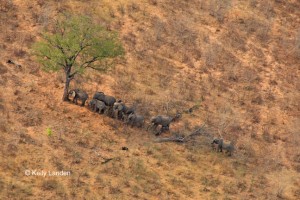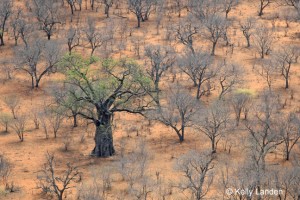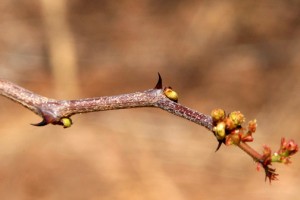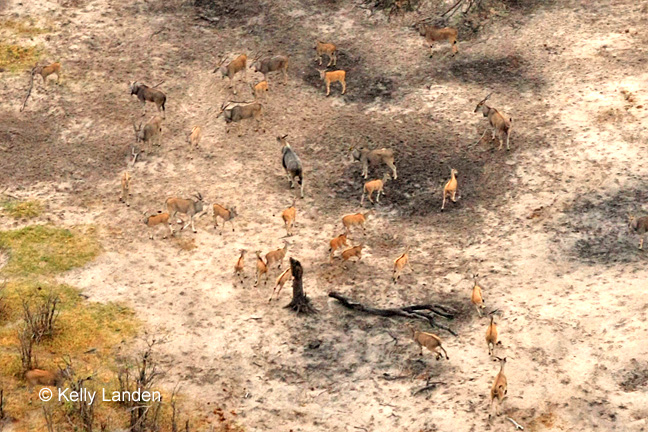Anticipating Rain… Pula!
We’ve been so busy in the field this season, when in from the bush and while in town, we are re-supplying, and can’t seem to find time to scramble and upload a blog to share. So much has happened that it is difficult to choose where to begin. However, at this time of year, one cannot ignore the immediate urgency of the relentless anticipation of waiting for the rains. Of course, one can feel it for one’s self. The heat is so intense in combination with the blistery winds intensifying it feels like an immense hairdryer blowing on one’s skin, all day.

An elephant family copes for shade
Nightfall doesn’t bring much relief, either. The clouds are building, capping the sky and trapping the humidity to add to the pressure. If it is quite intolerable for us people, it’s hard to imagine how it must be for the wildlife in some regions.
We have been flying all over northern Botswana (why are we flying? see http://www.elephantswithoutborders.org/surveys.php) and despite some very beautiful habitat in some areas, others are quite bleak. The vegetation is extremely barren, without a leaf on any tree not allowing for shade to keep the animals temperatures down, as they journey long treks between food and water sources. Huge fires devastated every blade of grass in their paths and the sandy soils are stark with a thin layer of black ash. To witness wildlife having to trek through this kind of harsh environment is quite distressing. But, this week it seems that relief is finally on its way!
We are experiencing and seeing signs everywhere. The cicadas have returned, jigging their mating dance and showing off their acoustical talents with their high-pitched trills. Their songs can some times be deafening and some cicadas produce sounds up to 120db and are among the loudest of all insect-produced sounds. Termites are busily repairing or building new mounds (also known as “termitaria”) to ensure proper thermoregulation within the elaborate tunnels and nest, and to shelter themselves from the rains. Mounds can reach up to 9 meters; however 2 to 3 meters is an average. We noticed 3 new mounds carefully constructed, directly behind our office this week.

Green leaved Baobab stands majestically
Signaling the end of winter with the arrival of spring, Baobab trees (the “Tree of Life” or “upside down” tree) donning new leaves, tower majestically within the forests. Baobabs store water inside the swollen trunk (up to 120,000 litres (32,000 US gal)) to endure the harsh drought and seem to be the first to wear green. Acacia, Terminalia, Mophane and most other trees and shrub species are coming into “leaf” and have small buds on the tip of every branch, waiting to burst out in splendor when the first good rain arrives. (see photos in our Gallery at http://www.elephantswithoutborders.org/photo_gallery.php)
As for the wildlife: recently flying and observing the herds and movements of the various species have given us opportunity to witness their response and reactions to the environmental conditions.

Buds on every branch are ready to burst into life
Impala are known to “extend” their gestation period to time birth in line with the rains. At the moment, the “mothers-to-be” look as if they are ready to burst and so heavy they seem unable to run. However, the situation is contrary to other species. Tsessebe, Eland, Zebra and Elephants have dropped their calves already and are urgently moving towards needed resources to replenish the nursing mothers. It is a testing and difficult time for them because food, water and shade to hide from the sun, may all be at quite some distances from each other.
However, we have received small bouts of showers in small patches throughout the region. It may be enough to give temporary cool relief and the occasional clay pan may hold enough water for the day. Unfortunately these sprinkles intensify the problems as they are a tease and “fool” the wildlife into thinking it is time to move towards green pastures, so they begin their journeys. But soon, they discover that the pastures aren’t green yet and find themselves in inhospitable areas, having to turn back around and retreat to decent conditions to wait. Our recent satellite collared elephant movements have shown us this, as well. A week ago, almost every elephant we are tracking made a dramatic move somewhere, all within the same few days, but now we see their tracks milling.
Every day, as we watch the clouds above build higher and higher, while the cicadas sing, we keep chanting in hope “Pula, pula, pula!” (Rain!)
“Pula” not only means rain in Setswaana, but it is considered so valuable, it is also the word for Botswana’s money denomination! If you’d like to help Elephants Without Borders, please logon to http://www.elephantswithoutborders.org/donate.php We guarantee our donors that their generous gifts go directly to their intended projects aimed at conserving elephants, wildlife and natural resources. Trumpets of Thanks for your Support!

We were pleased to see a few herds of Eland producing numbers of calves!
Tags: aerial survey count, africa, Baobab, behavior, botswana, conservation, elephants, elephants without borders, habitat, rain, research, wildlife







